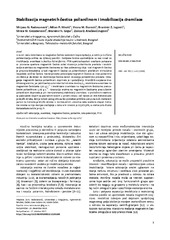Приказ основних података о документу
Polyaniline stabilization of magnetic particles and immobilization of alpha-amylase
| dc.creator | Radovanović, Mirjana N. | |
| dc.creator | Nikolić, Milan P. | |
| dc.creator | Đurović, Vesna M. | |
| dc.creator | Jugović, Branimir | |
| dc.creator | Gvozdenović, Milica | |
| dc.creator | Grgur, Branimir | |
| dc.creator | Knežević-Jugović, Zorica | |
| dc.date.accessioned | 2021-03-10T13:52:29Z | |
| dc.date.available | 2021-03-10T13:52:29Z | |
| dc.date.issued | 2018 | |
| dc.identifier.issn | 0367-598X | |
| dc.identifier.uri | http://TechnoRep.tmf.bg.ac.rs/handle/123456789/4026 | |
| dc.description.abstract | Magnetic particles (MAG), obtained by standard procedure of coprecipitation of Fe2+ and Fe3+ in an excess of ammonia, and polyaniline modified magnetic particles MAG-PANI were used as carriers for immobilization of a-amylase from Bacillus licheniformis. The formation of a polyaniline layer (PANI) on MAG particles was achieved by chemical polymerization of aniline. Immobilization was carried out by adsorption, as a simple, inexpensive and fast method that allows retention of a large portion of the initial activity of the immobilized enzyme. FTIR spectroscopy was used to characterize the obtained particles and to confirm changes dueto formation of a PANI layer and conjugation of a-amylase on the particle surfaces. Particle size distribution was bimodal and three-modal for MAG and MAG-PANI, respectively. Appearance of a fraction of smaller MAG-PANI particles than MAG particles could be attributed to the formation of PANI particles without the MAG core. Measured values of Zeta potential for MAG-PANI were higher as compared to MAG indicating stabilization of particles in the presence of PANI. Relevant kinetic parameters for immobilized enzyme were determined from the Hanes plot. The apparent K-m constant was 1.91 and 1.48 g L-1 for MAG-A and MAG-PANI-A, respectively, while V-m was 0.19 g L-1 min(-1) for MAG and 0.32 g L-1 min(-1) for MAG-PANI. The obtained values of K-m indicated that modification of MAG by PANI enhanced kinetic properties of the immobilized enzyme. Moreover, the modification of MAG by PANI showed the increase in both pH and thermal stabilities of the immobilized enzyme. Studies of the operational activity of the immobilized enzyme on MAG-PANI have shown that 98.8% of starch was hydrolyzed over 20.0 min. In the first cycle in the packed bed reactor operated in a recycling mode, but approximately five times longer period was required to hydrolyze 93.5 of starch in the fifth cycle. In the continuous packed bed reactor without recycling, the degree of starch hydrolysis was not changed significantly during 4 h and was 88.8 +/- 1.6%, whereas the half-life of the biocatalyst was 6.2 h. Although coating MAG particles with a polyaniline offers many advantages, the main disadvantage is possible appearance of residues of aniline monomers and dimmers. The potential toxicity of these residues requires precise composition analysis of the product of starch hydrolysis catalyzed by a-amylase adsorbed onto MAG-PANI. | en |
| dc.publisher | Savez hemijskih inženjera, Beograd | |
| dc.relation | info:eu-repo/grantAgreement/MESTD/Integrated and Interdisciplinary Research (IIR or III)/46010/RS// | |
| dc.rights | openAccess | |
| dc.rights.uri | https://creativecommons.org/licenses/by-nc-nd/4.0/ | |
| dc.source | Hemijska industrija | |
| dc.subject | Adsorption | en |
| dc.subject | alpha-Amylase | en |
| dc.subject | Magnetic particles | en |
| dc.subject | Polyaniline | en |
| dc.subject | Zeta potential | en |
| dc.subject | FTIR | en |
| dc.title | Polyaniline stabilization of magnetic particles and immobilization of alpha-amylase | en |
| dc.type | article | |
| dc.rights.license | BY-NC-ND | |
| dc.citation.epage | 12 | |
| dc.citation.issue | 1 | |
| dc.citation.other | 72(1): 1-12 | |
| dc.citation.rank | M23 | |
| dc.citation.spage | 1 | |
| dc.citation.volume | 72 | |
| dc.identifier.doi | 10.2298/HEMIND161213016R | |
| dc.identifier.fulltext | http://TechnoRep.tmf.bg.ac.rs/bitstream/id/1773/4023.pdf | |
| dc.identifier.scopus | 2-s2.0-85043790029 | |
| dc.identifier.wos | 000429312400001 | |
| dc.type.version | publishedVersion |

